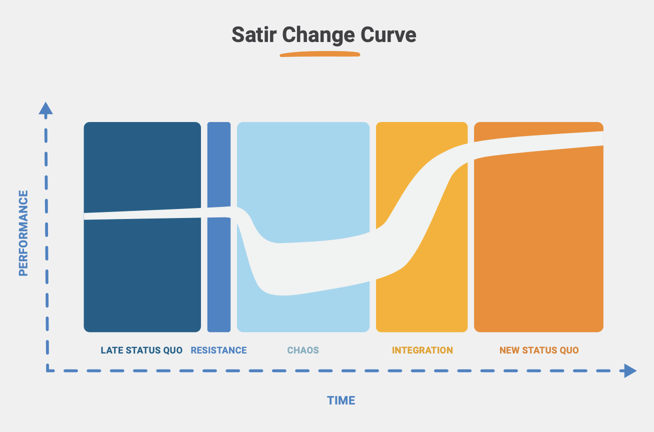Staying still isn’t your jam. You want to take your organization into the future. Maybe that means more diverse product offerings or growing headcount, but change can’t be limited to just one thing—and it starts from within.
For major organizational growth, you need to undergo a transformation. Explore how Agile transformation permeates your entire organization and how to best approach it.
What is Agile Transformation?
Transformation
noun
a thorough or dramatic change in form or appearance.
Think about what transformation looks like in nature, like when a caterpillar becomes a butterfly. It’s a drastic departure from its former self, upgrading its six legs by adding a pair of colorful wings for a new way to see and experience its world.
The same is true for organizations that undergo a metamorphosis. They completely shift away from the constraints that tie them to traditional approaches, because what got you here won’t necessarily get you there. Agile transformation is about realizing that what’s worked in the past isn’t alway sustainable. It’s a major mindset shift, requiring organizations and their teams to rethink:
- How to work
- How to measure success
- How to lead and manage people
Like the butterfly, you must transform and adapt to keep up.
How Long Does Transformation Take?
But here’s the thing: Agile transformation is a process. Think about the butterfly again. The caterpillar doesn’t go to sleep one night and wake up a winged creature. Instead, it goes into a cocoon for a prolonged period and undergoes countless changes before it emerges anew.
Truly transforming your culture and operations is an investment that can take several years. After all, you’re moving the organization’s mindset and behaviors toward a new status quo. So your timeline for transformation could depend on several factors:
- Company size
- Commitment from leadership to stay the course
- Experience level of change agents
- Differential between current culture and desired future state
Change happens on your timetable. But for what it’s worth, we’ve seen a clear trend: Large companies with more structure and policies have more difficult and time-consuming transformation processes than smaller counterparts. Set your expectations accordingly.
Seeing the benefits of Agility
What’s important to note is that while change happens gradually, you can see your efforts start to pay off in as quickly as a few months. This might be shown in something as simple as teams being more focused and able to get things done consistently.
But Agile transformation requires a sustained effort on all fronts. Both the quick wins and larger-scale changes are possible when teams do their part and leaders do too. Leaders need to be role models or sponsors of change, guiding the:
- Shift in values and culture
- Effort to continually course correct
It’s an adjustment. But the best way for leadership to foster organizational change is to shift their own approach, helping the new mindset and approach stick long-term for everyone.
What Does Real Transformation Require?
At Project Brilliant, we look at agile through three interconnected pillars: Products, Teams, and Leaders. And while it’s possible to address each separately, the real magic happens when you put the pieces together.
Products
Agile organizations deliver value through products. Products can adapt over time, making them long-lived means of giving customers what they want. In an Agile transformation, you redesign the organization around product value streams, rather than temporary projects to drive agility. Growing the product management capability of the organization is critical to support value streams and improves prioritization and business decision-making.
Teams
But to consistently deliver valuable products that meet customers where they are, you need the right people working effectively together. By establishing cross-functional and self-organizing teams, you can help transform them into high-performing teams. Eventually, teams of teams work together to expand the capacity of the organization to deliver on its highest priorities.
Leaders
Bring it all together! Leaders are vital to supporting the new approach to products and teams. It’s easy to underestimate your role in Agile transformation, but you and your peers are the role models for change, demonstrating the new culture and values of the organization and helping everyone else see the underlying value. But that doesn’t mean taking the reins. Instead, you can shift toward a catalyst style of leadership, empowering and supporting people to take risks, providing clarity of vision and transparency of information, and engaging people to utilize their skills and passions. By rallying people around a new approach, you can better develop and support a strong change management plan.
What Stands in the Way of Transformation?
“For every action, there is an equal and opposite reaction.” - Sir Isaac Newton
If Products, Teams, and Leaders propel Agile transformation, what’s counterproductive to it? A few key things can impede lasting change:
Making Superficial Changes
The struggle with Agile transformation is that you really do have to be all-in on the journey, and so many organizations aren’t. They realize that they’re unwilling to do the hard things, feeling more content to sub in quick, superficial changes instead. That’s because it’s easier to:
- Limit focus to functions like tech, IT, or engineering
- Lead as experts instead of catalyst leaders
Holding Too Tightly
Change is hard. It’s easy to cling to what’s comfortable, including policies and metrics that no longer make sense in your new Agile environment. Project management organizations (PMOs) must adapt. If you hold too tightly to the old mentality, it can create conflict.
Example: Imagine running two-week sprints in scrum, but teams still have to report on their progress toward a long project plan. As a result, they have to report on metrics that don't match their new planning horizon.
Quitting Too Early
Patience is a virtue that humans tend not to have. We don’t want to wait months or years for results. So all too often, organizations pull the plug when they don’t see quick improvement. The ones that fall into this bucket are unwilling to navigate the change curve, contributing to fad mentality and low employee engagement. But remember what we said about the caterpillar and butterfly? Trust the process; transformation is a journey.

Kickstart Your Agile Transformation
Agile transformation is a major shift in how organizations like yours operate to become more effective. And it’s a journey that can take a significant time investment to bring Products, Teams, and Leaders together as a well-oiled machine to better serve customers. But if you devote the time and attention, Agile transformation is well worth the effort.
So what can you do to begin driving transformation now?
Take it one step at a time to foster incremental improvements in certain areas. This could mean building cross-functional teams to limit dependencies and “us versus them” mentality—such as including QA to avoid delays—or just empowering teams to do the “how.”
You can even invest in manager professional development! Managers and leaders are critical to transformation success, so give them the right tools. Catalyst leaders work to empower people, provide a clear vision, and engage people’s passion.
Agile transformation takes time. By focusing on areas of critical need, you can start down the path to sustainable change. Find out what your organization could gain from going all-in on Agile. Explore our Key Agile Metrics and begin your journey toward improvement.





